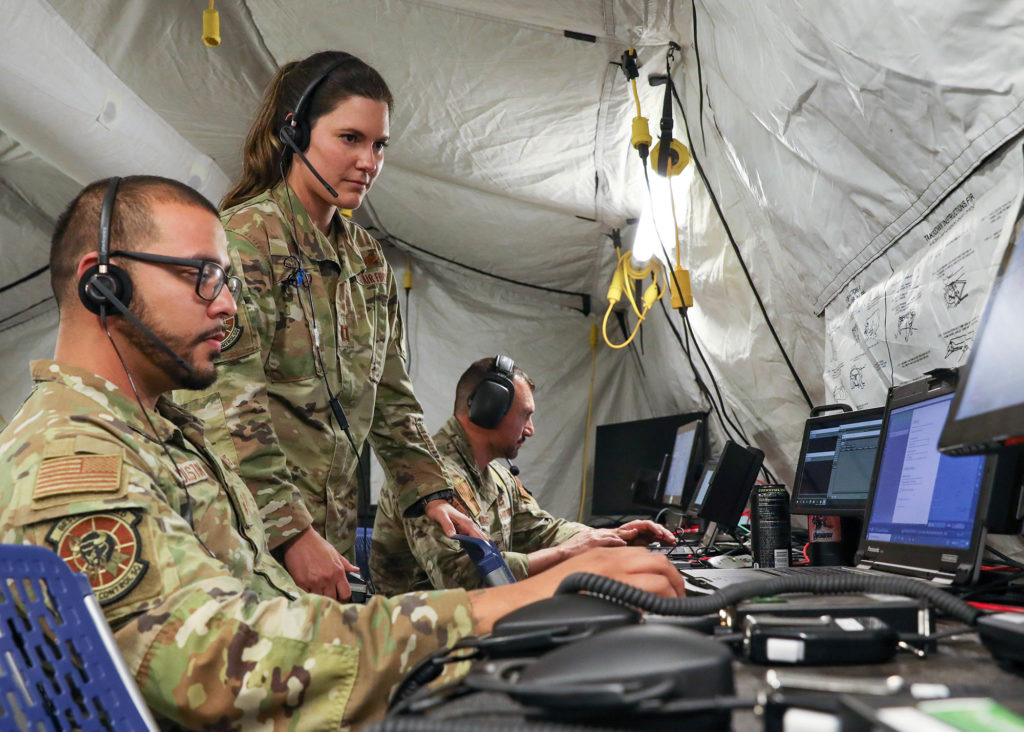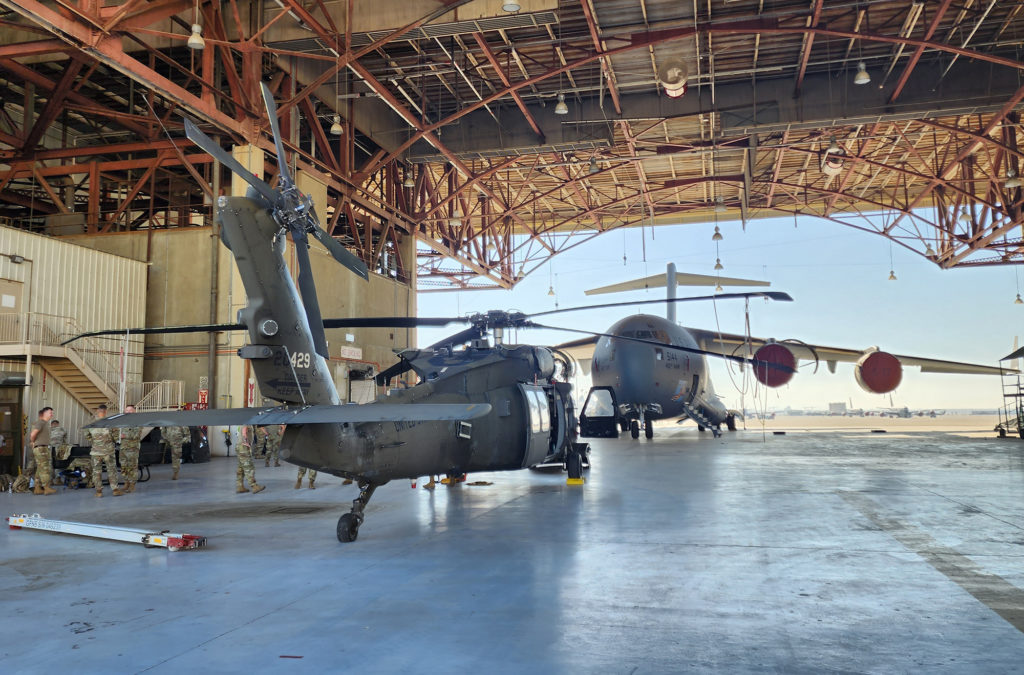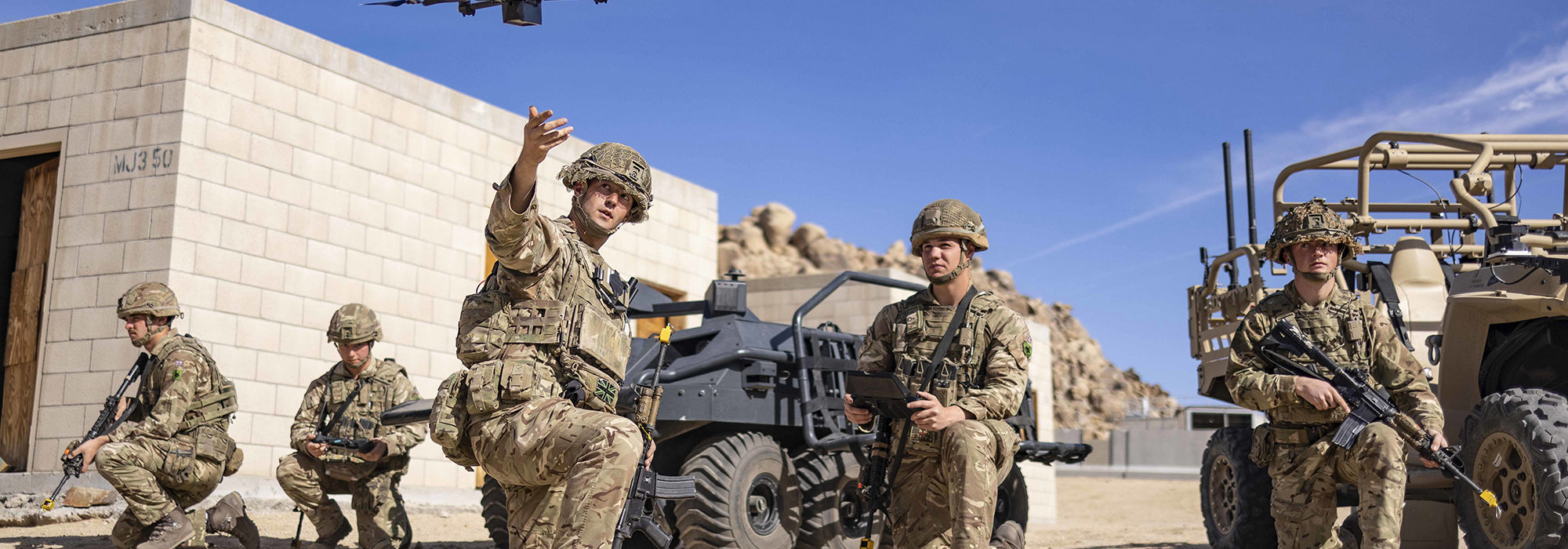Exercise exposes the inherent complexity of cross-domain, joint service operations.
FORT IRWIN, CA.
As the U.S. and allied militaries carried out a series of experiments in the chilly California desert in November, airspace management emerged as a pressing challenge. The Blue Force, representing allied forces in Europe, was operating advanced autonomous, sensing, and data capabilities to counter a Red Team, which served as a general proxy for Russian forces.
With so many drones in theater, the airspace grew congested, making it difficult to deconflict blue air and ground fire against the hypothetical foe.
In an enormous tent that shook as high winds swept across a training range the size of Rhode Island, Army Chief of Staff James C. McConville, an aviator by training, saw the problem clearly in the midst of a two-hour briefing. Airspace management for the joint force, he said, is mired in an “industrial age approach.”
The biggest thing we learned was … the network was the backbone, was the center of gravity.Lt. Gen. James M. Richardson, previous acting head of Army Futures Command
What is the point of slashing the time needed to identify and engage targets if it then takes hours to clear the skies in order for air or ground forces to act?
Welcome to Project Convergence 22, an Army-led effort to help the military adapt to intensified competition with China and Russia. The 2022 iteration began in September with a mock Pacific fight centered at Camp Pendleton, Calif., followed by a European scenario centered at Fort Irwin, Calif., the following month. In addition to U.S. Forces, British, and Australian units also took part.
“I think we all have the same vision of where we want to be,” McConville told reporters shortly before joining a convoy of SUVs and buses for a 30-minute journey along dusty roads to witness some of the new systems in action.
Getting there is the hard part. Army Futures Command, which runs the event, describes the experiments as a “campaign of learning,” meaning they are intended as much to identify future problems as to find solutions.
While the U.S. military fights as a joint force, each service has its own doctrine and systems for command and control. Even when the services do operate jointly, they previously looked at one domain at a time. For example, there might be a combined forces air component commander with responsibility for airspace and a combined forces ground component commander overseeing ground fighting. But linking the people and systems in each of those domains together remains a highly complicated challenge and the fundamental objective of joint all-domain command and control (JADC2), the idea that targets identified and tracked by any system in any domain can be attacked by the best possible shooter in any domain.
“It’s not like we’re going to go back and start with a clean sheet of paper,” McConville said. “We’re bringing together forces that have been optimized, maybe to communicate from the air or communicate from space, or communicate from the sea, or communicate from the ground. And we’re bringing all that together.”
British Army Lt. Gen. Sharon Nesmith, deputy chief of the U.K’s General Staff, noted that the conventional stove-piped view of each domain can be detrimental to success. “It’s slightly unhelpful to look at a particular domain on its own because we would always operate all-domain, joint, and combined,” she said.

Given that for more than 20 years, the United States has engaged as partners with allies in operations in Iraq and Afghanistan, Fort Irwin’s terrain still reflects those long wars. The demonstration took place on the outskirts of one of Fort Irwin’s combat towns, a constructed urban center in the desert called Ujen. The road leading into the city was still marked with signs in Arabic.
While those wars turned into grueling ground fights, the airspace was permissive; the Air Force flew manned and unmanned systems with virtual impunity. But in combat with more sophisticated foes, American air power faces far more complex threats, and foreign powers will see more complex operations by allied forces, as well.
In the Fort Irwin scenario, the Blue Force sought to improve integrated air and missile defense, test unmanned platforms, and defeat anti-access/aerial denial defenses. They also explored the challenges of logistics in a “contested environment,” where adversaries might use missile and cyber attacks to disrupt supply lines and the delivery of reinforcements.
An array of new systems, including unmanned technologies intended to free up crewed aircraft for other missions, were put to the test. In one demonstration, a swarm of unmanned systems quietly snuck up on a group of observers, ready to land and box-in an opposing force. In another, troops learned that something as simple as a GPS-guided airdrop could be disrupted if airspace was not sufficiently monitored and controlled.
For the Army, a hard lesson learned going forward was that they need a better solution to airspace management and that the Air Force will be heavily involved in finding a solution.
“That’s kind of new to us having all these sensors and everything inside that space,” said Lt. Gen. Charles R. Hamilton, the Army’s chief of logistics, when asked about airspace management.
U.S. and coalition air power had difficulty deconflicting air strikes, artillery fire, and rocket attacks when the U.S. helped Iraqi forces retake Western Mosul in 2017, according to a report by the U.S. Army’s Mosul Study Group. “For deliberate targeting, whether in support of deep shaping operations or a planned strike in support of the close fight, processing and approval took time,” the report said. It criticized what it termed “sub-optimal integration and synchronization of air assets with maneuver.”
Now, more than five years later, new unmanned systems have only made managing the airspace more complicated. More aerial systems make the skies more congested and deconfliction harder than ever. But in the event of a confrontation against a major adversary like China or Russia, McConville said, the U.S. must be able to rapidly integrate its myriad air and ground forces—not merely deconflict their operations. The issue was especially acute in the more confined European scenario, but also came up in the Pacific one, despite its vast, maritime focus.
“What we have to do and take advantage of is the ability to use data and the ability to use sensors,” McConville said. “Then we can operate with aircraft moving very, very close to each other. At the same time, we’re able to use fires, because we have much better situational awareness of where things are and where we want to go, and where our enemy forces are.”
The mission is easier said than done, and a host of technical problems remain, particularly in rapidly sharing data among Air Force and Army systems. The challenge is not merely to send data, but to come up with a software fix so that Air Force data is instantaneously translated into data the Army can use, and vice versa.
“From our perspective, when we do autonomous control, we’re sending requests for fires machine-to-machine,” said an Air Force officer supporting the event. “We’re able to send data machine-to-machine. What we’re not getting was closure that, No. 1, it was received on the other end, and No. 2, when they’re going to take that action. So now we don’t know if that implied task—clearing the airspace to allow that fire—is going to happen.”
During Project Convergence, the services were able to solve the problems via secure chat, but a more permanent, automated, and reliable fix is needed.
“That two-way conversation is important,” said an Air Force civilian involved in the tests. “The hindrance is the architecture that we had available to us and the data translators that we had available to us.”
Some of the artificial intelligence-aided systems used for targeting at Project Convergence, were FIRESTORM (short for FIRES Synchronization to Optimize Responses in Multi-Domain Operations) and SHOT (Synchronized High OPTEMPO Targeting), which help select targets and engage them from multiple platforms.
During Project Convergence, Air Force aircraft flying overhead engaged targets while ground troops looked at the FIRESTORM system. But FIRESTORM could not fully communicate with the Air Force aircraft, such as the close air support A-10 Thunderbolt II.
“From a FIRESTORM perspective, those A-10s were not shooters that were valid to be able to engage some of the targets that the tanks were seeing,” the expert said. “From a joint target pairing standpoint, FIRESTORM needs to be able to do those things.”
Project Convergence began in 2020 as an Army experiment applying new technologies to the future force. The annual exercise has since grown into a wide-ranging, joint exercise. The Army quickly learned its experiment needed to expand the network itself after the inaugural event. The 2021 iteration added service members and assets from Air Force, Navy, and Space force to expand its scope into something more applicable to how the U.S. military plans to fight future conflicts as a joint force. The 2022 version included allied participants as well.
“The biggest thing that we learned in Project Convergence 20, really, that the network was the backbone, was the center of gravity,” said Lt. Gen. James M. Richardson, then the acting head of Army Futures Command, at an event at the Center for Strategic and International Studies in February. “We also learned that a lot of our technologies don’t talk to each other. They’re not configured properly—the standards, the message formats.”
Instead of being a single service playground, Project Convergence now aligns with the Department of Defense’s overarching goals. The 2022 National Defense Strategy prioritizes the Indo-Pacific and Europe as the focus of America’s military posture, with China as the “pacing” and Russia as the “acute” or more ephemeral challenge. It also states the U.S. will work toward a more integrated force and work more closely with its allies and partners.
The U.S. and allies are “very close to being able to feel an all-domain force,” Lt. Gen. S. Clinton Hinote, the Air Force deputy chief of staff, strategy, integration, and requirements said. “And Project Convergence has showed me that is possible.”
Project Convergence 2022 tests included partners from allied nations in the two scenarios, as well as a technology exhibition. The experiments included thousands of troops, multiple American bases in the continental United States, Hawaii, and Australian forces based in Australia.
“It’s a series of experiments, but we are each year increasing the complexity, increasing the scale,” Secretary of the Army Christine Wormuth said. “While it is Army-hosted at the moment, it is truly a joint series of experiments. We’ve got all of the services participating, and then it’s also now multinational.

In 2020, the Air Force and Army entered into an agreement signed by McConville and Air Force Chief of Staff Charles Q. Brown Jr. to ensure data could be shared among the services. The effort is led by Army Futures Command, which hosts Project Convergence, and the Air Force’s office of strategy, integration, and requirements, led by Hinote.
The Air Force and Army will work together to address airspace management and data translation issues raised during the 2022 test, an Air Force spokesperson told Air & Space Forces Magazine.
Hinote expressed optimism that major progress could be made. “In the end, you’re going to see an all-domain force arise out of this, and it’s going to be incredibly compelling,” he said. That will not come easy, however. “We’ve still got a lot to do,” Hinote said. “We’ve still got a lot of data that we’ve got to figure out how to deal with. We’ve still got a lot of connectivity that we’ve got to figure out how to connect.”
